Koli barthad – quite simply, fried chicken – is one of those unassuming, ordinary sort of dishes that can transform a meal into something special. Easy to rustle up at short notice, since it does not bother with any complicated ingredients or equipment, it was a favourite, when unexpected guests arrived at estate homes. And if you happened to have a free-range bird on hand, descended from the Indian jungle fowl, which was always the case on a plantation, you were assured a richly flavoured dish to liven up the most mundane lunch or dinner. 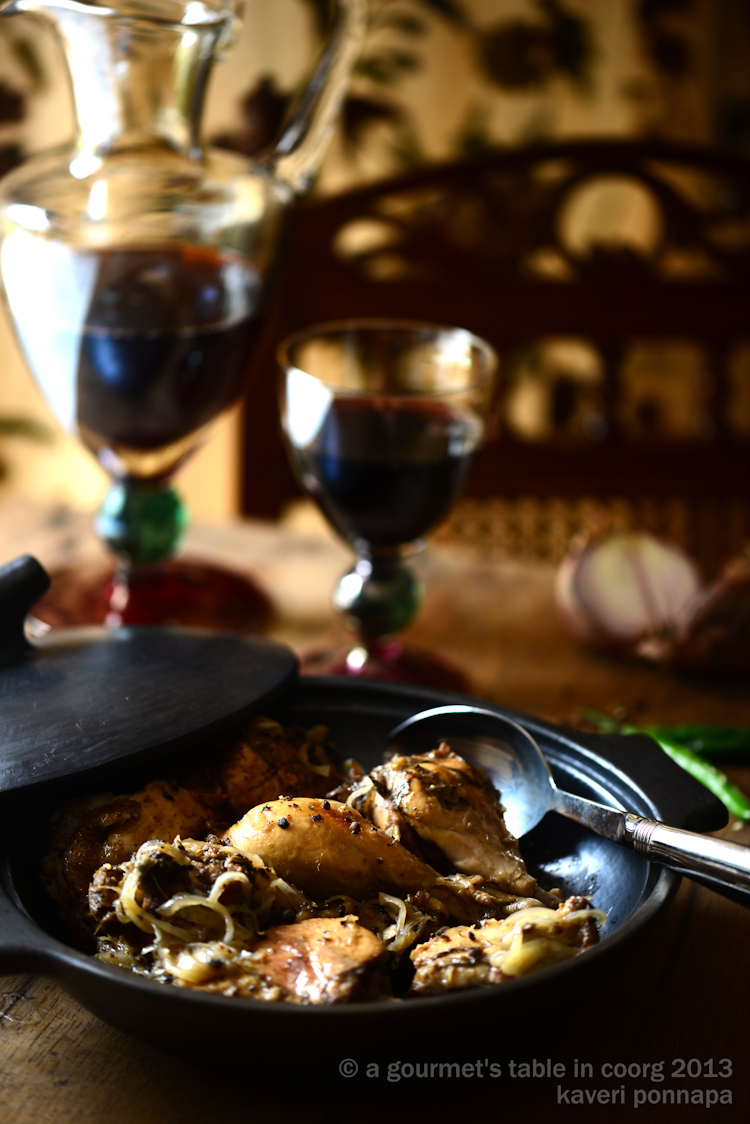 Although I have not done it here, Coorg chicken fry is usually cooked with the skin on, and the bird chopped into smallish pieces, something worth remembering, as the skin browns beautifully in large patches, and keeps the meat moist and tender on the inside. It is definitely a fry, with rather more oil than you would normally expect of a dish like this. Locally grown black peppercorns turn up, adding warmth to the sweetness of fried onions, working their way into the moist, shiny pieces of chicken, along with the additional sour power from the Coorg vinegar, kachampuli. A few fresh green chilies blend in well, adding more bite, if you wish it.
Although I have not done it here, Coorg chicken fry is usually cooked with the skin on, and the bird chopped into smallish pieces, something worth remembering, as the skin browns beautifully in large patches, and keeps the meat moist and tender on the inside. It is definitely a fry, with rather more oil than you would normally expect of a dish like this. Locally grown black peppercorns turn up, adding warmth to the sweetness of fried onions, working their way into the moist, shiny pieces of chicken, along with the additional sour power from the Coorg vinegar, kachampuli. A few fresh green chilies blend in well, adding more bite, if you wish it. 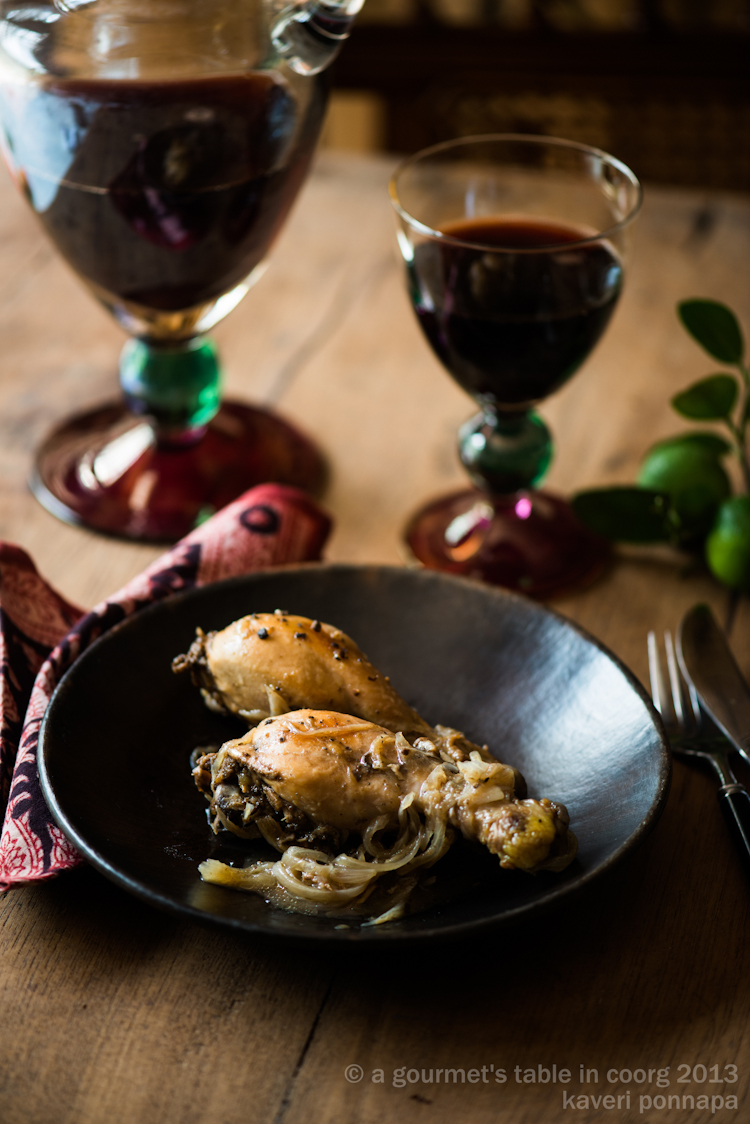 I cook this in an ancient khadai, waiting for a thick, sticky sauce to form at the bottom of the dish, and after a while, the spice infused oil floats to the surface, adding a glaze to the meat. The layer of browned spice and oil that coats the vessel is scraped off with care and added to the serving platter, along with twists of silky onions. The rich, condensed sauce clings to the pieces of chicken, and to your fingers, which you cannot help licking. From a spare palette of ingredients, a perfect balance of flavours emerges. You end up scraping the plate for every last smear of this unctuous, delicious offering.
I cook this in an ancient khadai, waiting for a thick, sticky sauce to form at the bottom of the dish, and after a while, the spice infused oil floats to the surface, adding a glaze to the meat. The layer of browned spice and oil that coats the vessel is scraped off with care and added to the serving platter, along with twists of silky onions. The rich, condensed sauce clings to the pieces of chicken, and to your fingers, which you cannot help licking. From a spare palette of ingredients, a perfect balance of flavours emerges. You end up scraping the plate for every last smear of this unctuous, delicious offering. 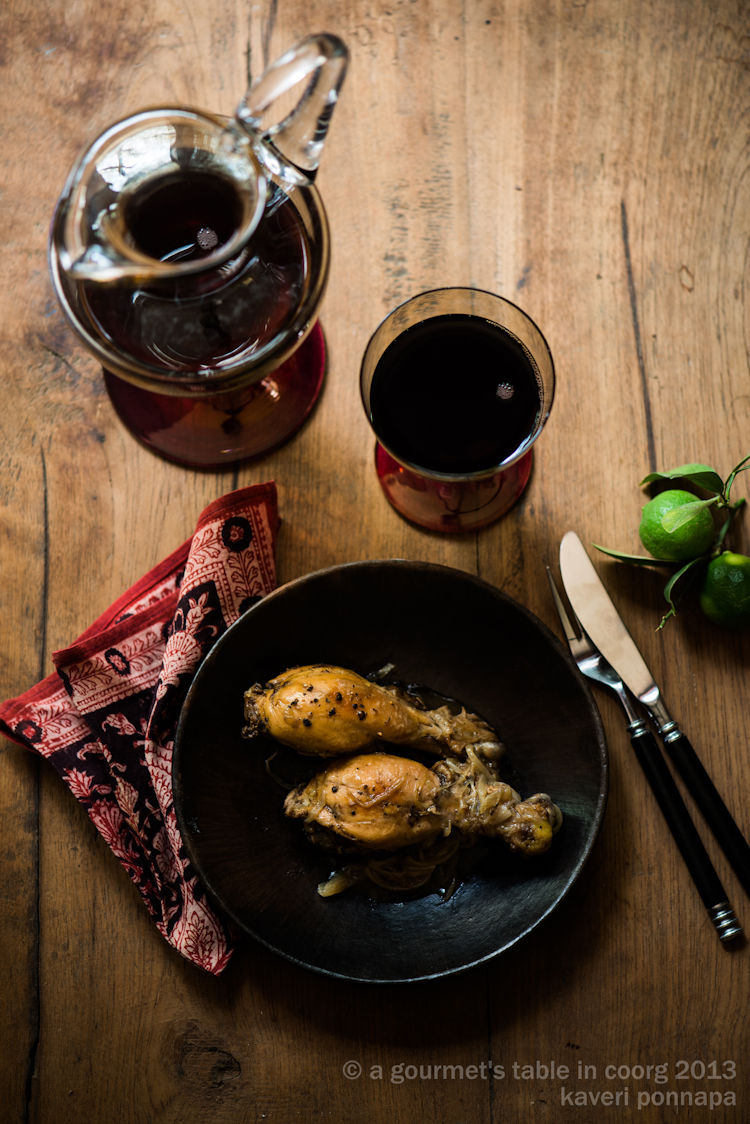
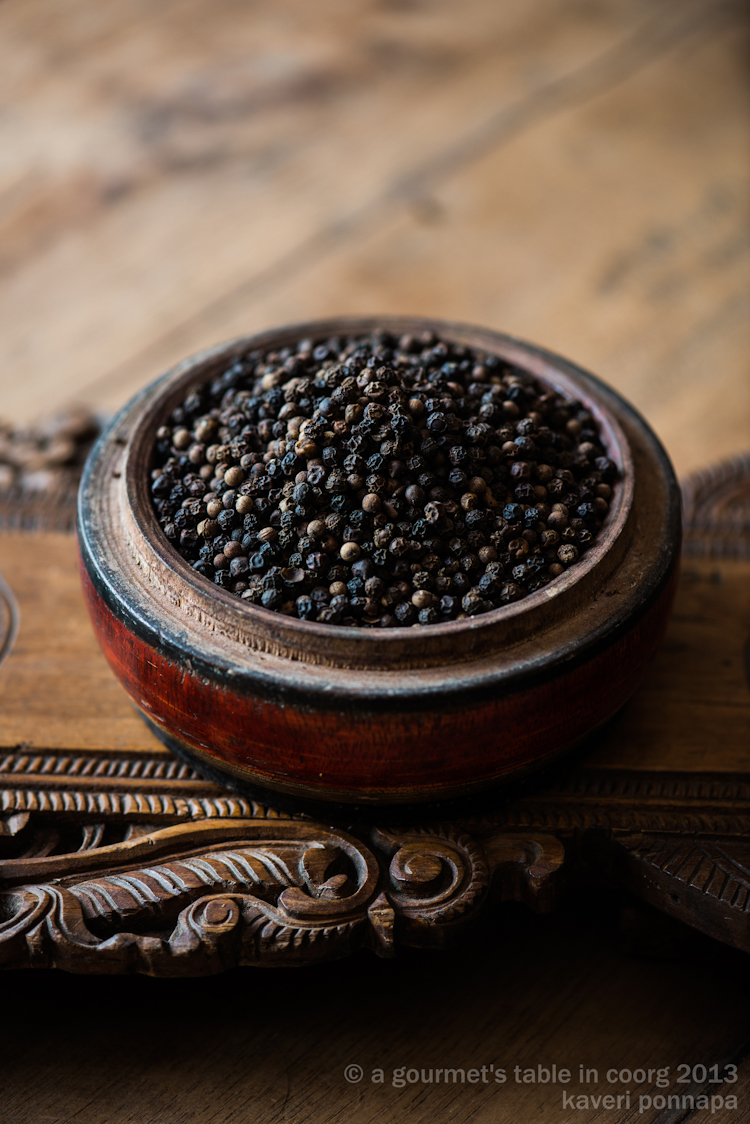
An everyday dish from our everyday kitchens, koli barthad is now something of a celebrity. It features on the menu of one of the most famous restaurants in the country, Karavalli. It found its way onto the five-star table via Chef Naren Thimmaiah; this celebrated Chef follows his mother’s recipe, keeping the dish determinedly simple, which is the secret of its appeal. And in the meanwhile, its status as a favourite on so many Coorg tables remains unchanged.
Koli Barthad
Coorg Chicken Fry
Ingredients:
- 1kg chicken, cut into curry-sized pieces, preferably with skin
- 2 large onions, thinly sliced
- 3 inch piece of ginger & 8-10 cloves of garlic, ground to a fine paste with very little white vinegar, approx. 2 tbsp.
- 1 level tsp turmeric
- 3-4 fresh green chillies, slit along their length
- 1 ½ generous tbsp. freshly ground black pepper (or more, according to taste)
- 1 level tbsp. kachampuli (use double the quantity of dark malt vinegar as a substitute)
- ½ cup oil for frying
- salt to taste
- 2 cups water
Method:
- Cut the chicken into serving sized pieces, mix in the salt, turmeric, garlic- ginger paste, freshly ground pepper, & set aside for about 15 mins.
- Heat the oil in a khadai or a wide pan, and fry the sliced onions on a low fire, until medium brown.
- Add the chicken with the spice paste, and fry on a low flame for about 10-12 mins.
- Add 2 cups hot water, and cook, covered, until the water almost evaporates, the chicken is tender, and the spice paste thickens. Then add the green chillies.
- Stir in the kachampuli, and simmer gently until the oil rises to the surface.
Cook’s Note:
Chicken is generally cooked with the skin on, in Coorg, to give a fuller flavour to the dish. You can cook it without the skin, if you prefer. If you like a spicy fry, you can add red chilli powder to taste at the stage when you add the spice paste to the pan.
And given below is a recipe for a lighter version of this dish, for the health-conscious: but I have to say that the delicious oiliness of the original is what I love!
A Lighter Chicken Fry
- Reduce the quantity of oil in the recipe to ¼ cup.
- Follow the method for Koli Barthad upto step 3. Since you are using reduced oil here, if the spice paste begins to stick, sprinkle small quantities of water into the vessel with your fingertips as you cook the spice mixture.
- Add approximately 1cup water to the chicken and spices, and pressure cook on medium heat for 10 mins, taking care not to overcook the chicken – this will give you a moist, tender chicken, without the extra oil.
- Place pressure cooker under running water until the pressure drops.
- Open, transfer to a khadai, or you could continue cooking the chicken in the pressure cooker on a medium flame until the water reduces, so that a thick spice paste is formed. Follow the rest of the recipe in step 5.
Thank you for visiting this page. If you read something that you enjoy, or see an image that you like, please take a moment to write a response. Do look out for the recipes of all the food featured here in my upcoming cookbook.
Image Credits: Nithin Sagi
All Food Styling: Kaveri Ponnapa

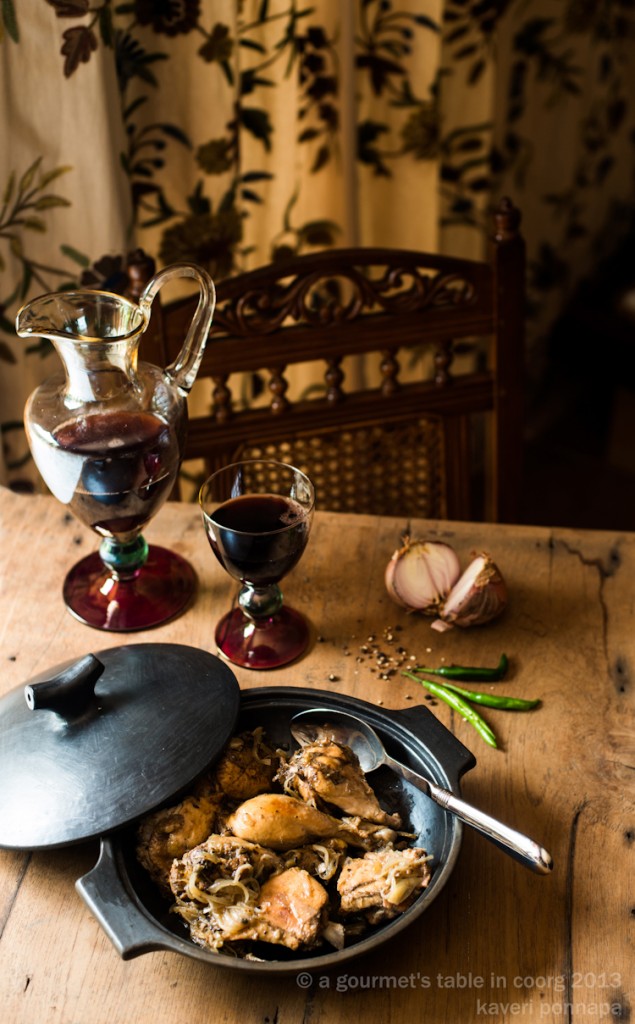
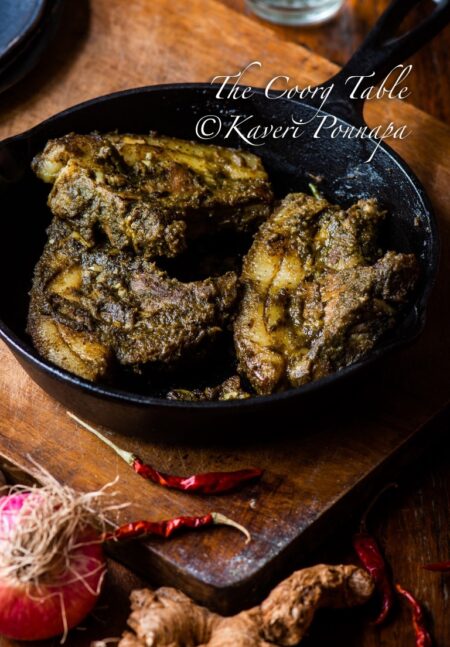
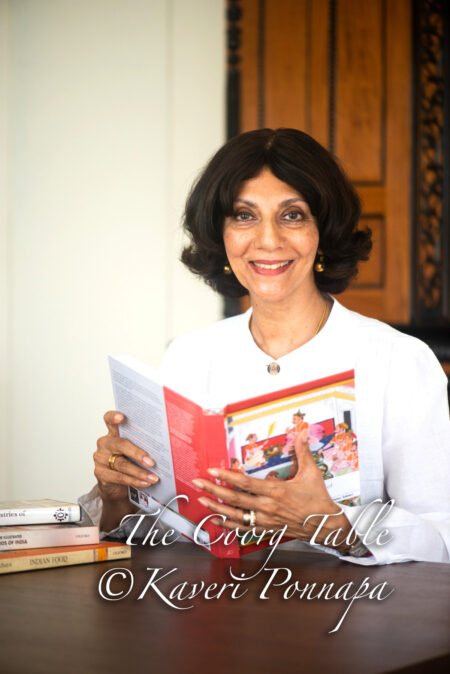
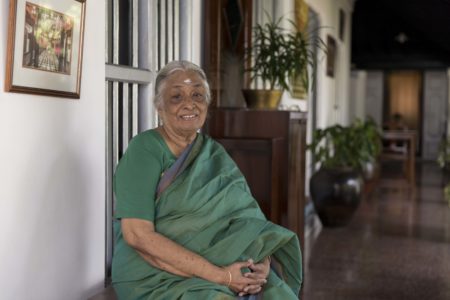
Easy to make and taste is delicious. Though health conscious for this one I went with the extra oil .Worth working out extra next day .I did add a bit of red chilli powder and garam masala powder too .
Hello Chitra, thank you for sharing that the chicken turned out well—this is a very popular dish at home, and with guests. I completely agree with you that the extra oil is worth some extra effort to work it off! The gravy becomes very delicious with the oil.Do keep reading, Kaveri
the dish turned out perfect and everyone liked it. I agree the kachampuli makes the difference. I am going to try out more of the recipes and mail you if doubts arise. meanwhile happy cooking.
Hi Julie, this is brilliant! I’m delighted to have this feedback from you that everyone enjoyed the chicken fry. It’s one that can be made without too much effort, and quite a crowd pleaser. Do try more recipes,and you are very welcome to mail me if you have any doubts or queries. Warm wishes, Kaveri.
Hi Kaveri, it all looks so delicious and love the way you have designed the site. I am trying out this recipe today, will post you on the results!
While there is lot of effort to see oil is reduced in nowadays cooking I see much of it being used in your receipe. Any way to reduce it? I Know it is difficult considering the extensive usage of it in Coorg homes, but give it try without making it tasteless and raw. Kachampuli will discolour the meat so it is not used for chicken but is used for fish and pork curries!!!!!!!!
Hello! You can always reduce the quantity of oil if you wish,according to your personal taste,but for this recipe,1/2 cup for 1 kg chicken gives you the best flavour. About kachampuli – it is certainly used traditionally for chicken fry,also chicken curry, crab, fish and a lot of vegetable fries and curries. The colour of the vinegar does darken every dish, so if you prefer, you can use tomatoes, but the flavour will not be the same.
My experience is that kachampuli works well with pork and fish. Must try out your recipe. Vivek
Hi Vivek, this recipe is from my mother-in-law. It’s really delicious,and very easy to cook, so we end up making it often. Kachampuli works very well with chicken, both in this fry and a curry too. We use it for mutton chops,keema, mushrooms and many vegetables too, like brinjal fry. Hope you enjoy the chicken fry!